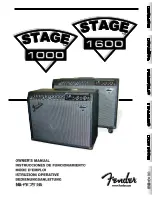
17
Operation
Equalizer
The Low Band filter can be applied in many ways. Examples are; to accen-
tuate the fundamental sound of a voice, to cut ”boom frequencies” and for
placement of bass emphasized instruments such as bass guitar, bass drums-
or synthesizers during recording or subsequently when mixing etc.
Recommendation on frequency settings: To find the frequency which is
to be processed as quickly and accurately as possible the Cut/Boost control
should firstly be adjusted to the maximum position. Subsequently the rele-
vant frequency should be sought. Following this the required boost or cut
can be set with the Cut/Boost control. Because the filter at maximum setting
works with the smallest bandwidth the frequencies can be heard most
distinctly at this setting, making them easier to locate.
Distortion
The Distortion control offers the capability of applying distortions to
signals. The distortions are infinitely variable from Off through to distinctly
perceptible harmonics. The distortion stage is located in front of the equa-
lizer so that the even newly created spectrums can be processed with the
EQ.
The overmodulated field-effect transistor which forms a part of the distor-
tion circuitry has a similar characteristic curve as a tube and sounds distin-
ctly ”warmer” than a pure diode- distortioner.
The signal level is of utmost importance to the operating mode of the
Distortion module. To achieve useful results the level should lie in the range
0 to + 6 dB. Over and above this the results are strongly dependent on the
condition of the input signal and its spectrum. The processing of sinewave-
like signals (e. g. E-piano, vocal, guitar) is audible much earlier than signals
with predominant harmonical contents (e. g. snare drum, hi hat etc). It is
recommended that time and effort is taken to find the correct setting.
IMPORTANT: To avoid exasperation during recording it is recommended
that the EQ controls, in particular the Distortion control, are initially set to Off
or 0! If not, tonal changes will occur immediately and furthermore, in the
case of the Distortion control, additional distortions.
Summary of Contents for 9945
Page 1: ...Model 9945 Manual Channel Strip...
Page 6: ...6 Connections Rear Front Wiring...
Page 23: ...23 Block Diagram Channel One Model 9945 1999 SPL electronics GmbH...
Page 27: ...27 Copy Master...
Page 28: ...28 Manual Notes...












































